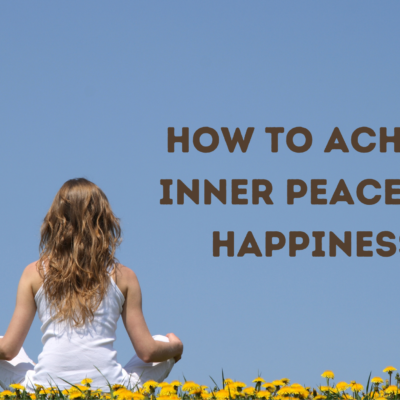How to Achieve Inner Peace and Happiness: In a world filled with constant noise, stress, and distractions, the pursuit of inner peace and happiness can seem like an elusive goal. Yet, achieving inner peace and happiness is possible with the right mindset and practices. It’s not about external circumstances but rather about how we respond to them and find contentment within ourselves. This article explores practical steps to help you cultivate inner peace and happiness in your life.
Also Read:
- How to Train My Brain to Think Positive?
- How to Stop Being so Anxious all the Time?
- How to Stop Overthinking the Future?
How to Achieve Inner Peace and Happiness:
1. Understand the True Meaning of Inner Peace and Happiness
Before embarking on the journey to inner peace and happiness, it’s important to define what these terms truly mean. Inner peace is the state of mental and emotional calmness, with no anxiety or stress. It is the ability to stay grounded and serene in the face of challenges. Happiness, on the other hand, is a state of joy, contentment, and fulfillment that comes from within, not from external achievements or possessions.
Both inner peace and happiness are deeply personal, and what brings them can vary from person to person. However, the common thread is that both come from within, and they require us to cultivate a peaceful mind and positive emotions.
2. Practice Mindfulness and Meditation
Mindfulness and meditation are powerful tools for cultivating inner peace. Mindfulness is the practice of being fully present in the moment, without judgment. It helps you detach from distractions and stop overthinking. By being mindful, you become more aware of your thoughts, emotions, and reactions, allowing you to choose how to respond rather than react impulsively.
Meditation, particularly deep breathing and focused attention practices, helps calm the mind, reduce stress, and create a sense of inner calm. Even just 10 to 15 minutes of meditation a day can have a profound effect on your mental and emotional state. The more you practice mindfulness and meditation, the better equipped you will be to handle life’s stresses with calmness and clarity.
3. Let Go of Negative Thoughts and Emotions
Holding on to negative thoughts and emotions, such as anger, guilt, or resentment, can block inner peace and happiness. These emotions create internal turmoil and prevent you from living fully in the present moment. To achieve inner peace, it’s essential to release these negative emotions.
Start by acknowledging and accepting your feelings rather than suppressing them. Allow yourself to feel and process them, but don’t let them control your thoughts or actions. Techniques like journaling, therapy, and forgiveness can help release emotional baggage. Letting go of the past and practicing self-compassion can free you from the weight of negativity and open up space for peace and happiness to flourish.
4. Embrace Acceptance
Acceptance is a cornerstone of inner peace. Many of us spend too much time resisting reality, wishing things were different or trying to change things beyond our control. This resistance often leads to frustration and anxiety. By accepting life as it is, including its imperfections and uncertainties, we can reduce stress and cultivate peace.
Acceptance doesn’t mean resignation. It means recognizing and embracing life’s challenges, understanding that they are part of the human experience. When you accept the present moment as it is, you can respond to it with calmness and wisdom, rather than resistance and fear. The ability to accept yourself, others, and the circumstances around you is key to finding happiness in any situation.
5. Focus on Gratitude
Gratitude is a powerful practice that can dramatically improve your sense of well-being. When you focus on what you are grateful for, rather than what you lack, you shift your perspective. Gratitude helps you appreciate the small joys in life, making it easier to find happiness in everyday moments.
To cultivate gratitude, start by keeping a gratitude journal. Each day, write down three things you are grateful for. They can be as simple as a beautiful sunrise, a good cup of coffee, or a kind gesture from a friend. Over time, this practice shifts your focus from what’s wrong in your life to what’s going right. The more you practice gratitude, the more your happiness will grow.
6. Cultivate Positive Relationships
The relationships we maintain have a significant impact on our emotional and mental well-being. Surrounding yourself with people who uplift, support, and love you creates a positive environment that fosters peace and happiness. Toxic relationships, on the other hand, can drain your energy and create unnecessary stress.
Take time to nurture your relationships with family, friends, and loved ones. Engage in meaningful conversations, spend quality time together, and offer your support when needed. Healthy, positive relationships create a sense of belonging and help you feel more connected to the world around you, which contributes to your overall sense of peace and happiness.
7. Take Care of Your Body
Physical health and mental well-being are deeply interconnected. When you take care of your body, you create a foundation for inner peace and happiness. Exercise, nutritious food, and proper rest all play a vital role in maintaining emotional balance and reducing stress.
Engage in regular physical activity, whether it’s yoga, walking, dancing, or any form of exercise that you enjoy. Exercise releases endorphins, which are natural mood boosters that help you feel happier and more energized. Eating a balanced diet full of whole foods, staying hydrated, and getting enough sleep also contribute to a peaceful mind and a joyful spirit.
8. Engage in Meaningful Activities
Inner peace and happiness often come from doing things that bring a sense of purpose and fulfillment. Whether it’s a creative hobby, volunteering, or pursuing a passion project, engaging in activities that align with your values and interests can bring great joy. When you do something meaningful, you feel more connected to yourself and to the world.
Take time to explore what makes you feel alive and inspired. If you haven’t already, consider setting aside time each week to engage in activities that nurture your soul. This could be painting, hiking, writing, volunteering, or anything that makes you feel connected and fulfilled.
9. Let Go of Perfectionism
Perfectionism is a major source of stress and dissatisfaction. The constant desire to be perfect or meet unrealistic standards can make you feel inadequate and unhappy. Achieving inner peace requires letting go of the need to be flawless and embracing the beauty of imperfection.
Understand that nobody is perfect, and mistakes are a natural part of life. Rather than striving for perfection, focus on doing your best and embracing the learning process. When you let go of perfectionism, you free yourself from unnecessary pressure and allow yourself to experience joy and contentment in your efforts, regardless of the outcome.
10. Live in Alignment with Your Values
When your life is aligned with your core values, it becomes easier to experience inner peace and happiness. When you’re living in accordance with what truly matters to you, you feel more authentic and fulfilled. On the other hand, when you live in conflict with your values, you may feel inner turmoil and dissatisfaction.
Take time to reflect on your values and ensure that your actions and decisions align with them. This could involve making career choices that resonate with your passion, fostering relationships that reflect mutual respect and trust, or living a lifestyle that supports your well-being.
11. Practice Self-Compassion
Lastly, practicing self-compassion is key to achieving inner peace and happiness. Be kind to yourself when you make mistakes or face difficulties. Avoid harsh self-criticism, as it can lead to feelings of guilt, shame, or frustration. Treat yourself with the same care and understanding that you would offer a loved one.
Self-compassion allows you to accept your flaws and imperfections, which ultimately leads to greater peace and happiness. When you love and care for yourself, you create a solid foundation for living a balanced and joyful life.
Conclusion
Achieving inner peace and happiness is a continuous journey that requires practice, patience, and self-awareness. By embracing mindfulness, releasing negative emotions, practicing gratitude, fostering positive relationships, and living in alignment with your values, you can create a life that is peaceful and fulfilling. Remember that happiness comes from within, and the key to lasting peace and joy lies in nurturing your inner world. With time and dedication, you can achieve a state of inner peace that allows you to embrace each moment with calmness, contentment, and happiness.








